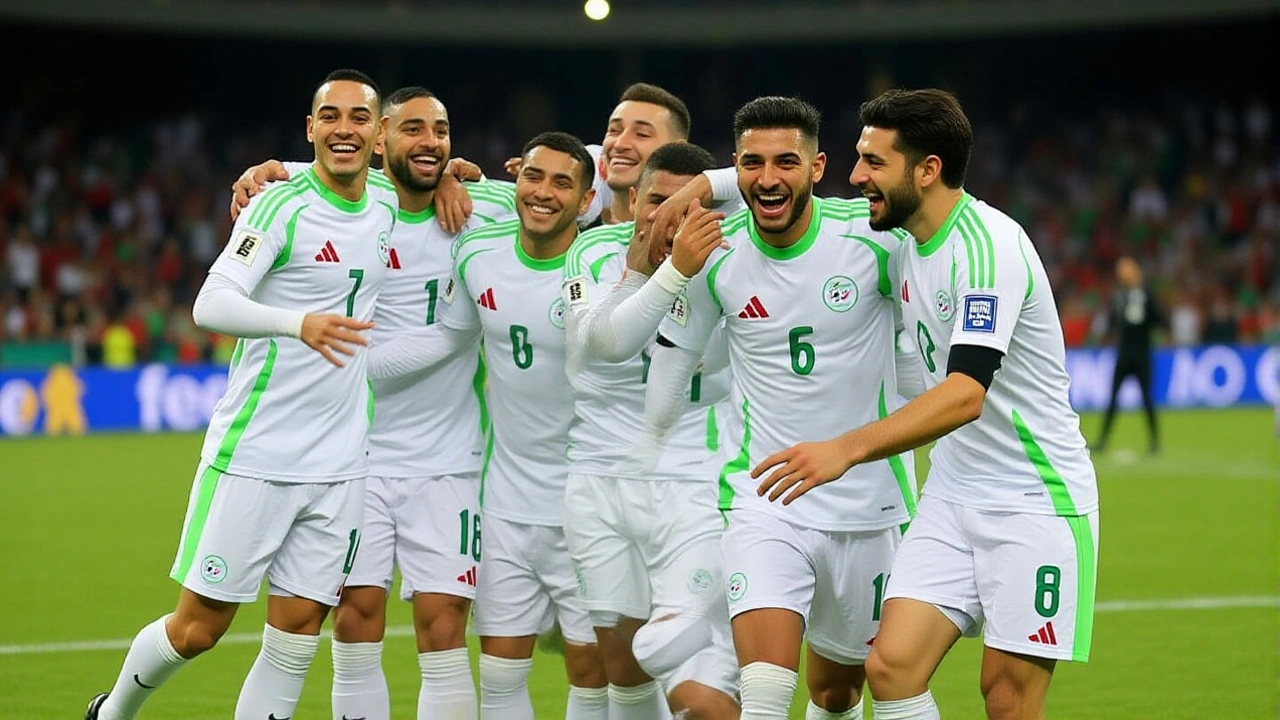When Tunisia edged out Equatorial Guinea 1‑0, the FIFA confirmed on its website that the Carthage Eagles had locked in a berth for the 2026 FIFA World Cup. The decisive match, played in early November 2025 at the Stade Olympique de Radès, gave Tunisia the continent’s newest representative and raised the total of already‑qualified nations to five – Japan, New Zealand, Iran and Argentina – out of the 45 slots still up for grabs.
Key Facts
- Qualified team: Tunisia (CAF)
- Opponent: Equatorial Guinea
- Scoreline: 1‑0
- Match date: 8 November 2025 (official FIFA confirmation 9 Nov)
- Remaining qualification spots: 40 across six confederations
How the global qualification maze works
The road to the tournament is a patchwork of formats, each designed by a regional governing body. In Africa, the Confederation of African Football (CAF) runs a multi‑round knockout that culminates in a final group stage; the winners of those groups earn direct tickets, while the best runners‑up move to inter‑confederation play‑offs. Europe’s UEFA runs twelve groups of four or five teams; the group winners qualify automatically, and the second‑placed sides drop into a March 2026 play‑off mini‑tournament.
South America’s CONMEBOL sticks to the classic round‑robin league of ten teams, playing home and away from September 2023 onward. The top six secure World Cup places, with the seventh heading to the play‑offs. North, Central America and the Caribbean – under CONCACAF – sifted from a first‑round knockout to a third‑round group phase, where three group winners advance directly and the two strongest runners‑up join the inter‑confederation draw.
Asia’s AFC began early, on 12 October 2023, when Myanmar’s Lwin Moe Aung netted the inaugural goal of the entire qualification cycle. The Asian route blends a first‑round knockout, a second‑round group stage and a final round where the top two finishers lock in spots, while the third‑place team moves to the play‑offs. Oceania’s OFC, the smallest confederation, sends its champion to the inter‑confederation tournament, where they must win two single‑elimination games to book a World Cup berth.
Timeline: From the first kick‑off to the final whistle
The qualification campaign stretches over nearly three years. Asian lower‑ranked nations kicked off in October 2023, while the European qualifiers didn’t begin until 21 March 2025. The UEFA group stage runs through November 2025, with play‑offs slated for 26 and 31 March 2026. South America’s round‑robin wrapped up in late 2025, and the CONCACAF third round will finish by November 2025. The inter‑confederation play‑offs – a two‑stage, single‑elimination showdown – are set for March 2026 in Mexico, with the winners earning the final two World Cup tickets.
Meanwhile, the host trio – the United States, Mexico and Canada – automatically qualify, expanding the tournament to 48 teams. The competition itself will run from 11 June to 19 July 2026, spreading across 16 cities in North America.

Reactions from the dugout and the studio
“We’ve waited a long time for this moment,” said Moncef Mekacid, Tunisia’s head coach, in the post‑match interview. “The fans deserved this, and the whole nation can now dream of a June‑July celebration on three continents.” The Carthage Eagles’ striker, who slotted the winning goal, described the feeling as “pure euphoria – a gift for every kid who plays football on our streets.”
Analysts in Europe were quick to note the shifting balance in Africa’s qualifying table. Former CAF president Kwesi Appiah warned that Tunisia’s triumph adds pressure on traditional powerhouses like Senegal and Nigeria, who now must navigate a tighter playoff path.
In Japan, where the national team became the first to qualify back on 20 March 2024, the media celebrated the early success but cautioned that the long road ahead – especially with the Asian qualifying rounds still in full swing – could prove “a test of depth and endurance.”
The remaining road: What the 40 open spots mean for fans
With only about 10 % of the tournament’s places secured, the next two years will be a roller‑coaster for nations across every continent. For smaller footballing nations, the inter‑confederation play‑offs offer a lifeline; a single win in Mexico could catapult a team like Oman or Uruguay’s neighbour, Paraguay, onto the world stage.
Broadcasters are already lining up rights packages, betting that the drama of late‑stage qualifiers – especially the March 2026 run‑offs – will draw record viewership. Sponsors, too, are watching the numbers: FIFA expects the expanded format to generate roughly $2.3 billion in additional revenue, a portion of which will be funneled back into grassroots programs in Africa and Asia.
For the fans in Tunis, the victory is more than a ticket; it’s a cultural moment. Streets in downtown Tunis erupted with chants, and local bakeries reported a surge in sales of “World Cup” pastries. If history is any guide, the tournament’s host cities – from Los Angeles to Toronto – will become a global stage where stories like Tunisia’s are told alongside football giants.

What’s next for the Carthage Eagles?
Now that the qualification is sealed, Tunisia will turn its focus to preparation. The federation announced a summer training camp in France, with friendly matches scheduled against Belgium and Portugal in March 2026. The goal, according to federation president Wajdi Mokni, is “to build a squad that can compete beyond the group stage, perhaps even pull off an upset against a traditional powerhouse.”
All eyes will be on the upcoming UEFA play‑offs, the South American league table’s final stretch, and the CONCACAF group deciders. Until then, the world will keep watching as the 2026 FIFA World Cup field slowly fills out, one historic win at a time.
Frequently Asked Questions
How does Tunisia’s qualification affect other African teams?
Tunisia’s win tightens the race for the remaining CAF spots. Nations like Senegal, Nigeria and Ghana must now aim for the top of their groups or rely on the play‑off route, which means an extra set of high‑pressure matches in March 2026.
What is the format of the inter‑confederation play‑offs?
Six teams – one each from AFC, CAF, CONMEBOL and OFC, plus two from CONCACAF – meet in Mexico in March 2026. The four lowest‑ranked teams play single‑elimination matches; the winners then face the two highest‑ranked teams, with the final two victors earning World Cup berths.
When and where will the 2026 World Cup be held?
The tournament runs from 11 June to 19 July 2026 across 16 cities in the United States, Mexico and Canada. Matches will be staged in iconic venues such as MetLife Stadium in New Jersey and the Estadio Azteca in Mexico City.
How many qualification spots are still open?
With five teams already qualified, 40 spots remain. These are distributed among UEFA (12 direct, plus play‑off chances), CAF (5 direct, 1 play‑off), CONMEBOL (6 direct), CONCACAF (3 direct, plus play‑off chances), AFC (8 direct, plus play‑off), and OFC (1 direct). The exact allocation can shift with the play‑off outcomes.
What are experts saying about Tunisia’s chances at the tournament?
Football pundits note that Tunisia’s disciplined defense and quick counter‑attack could surprise groups that underestimate African sides. However, they also caution that the step up in competition level demands depth, especially in midfield, where injuries could prove costly.

Henry Cohen
October 9, 2025 AT 01:36So Tunisia finally made it, but the CAF is still a mess. Lucky win over a weak side means nothing.
They barely scraped past Equatorial Guinea and now act like they own the continent.
Mark Langdon
October 9, 2025 AT 23:00Seeing the Carthage Eagles celebrate brings a smile to any football fan. The streets of Tunis deserve that joy after years of near‑misses. It’s a reminder that dedication at home can translate to a spot on the world stage.
Ciara Russell-Baker
October 10, 2025 AT 20:23Honestly, Tunisia’s qualification just adds pressure on the usual heavyweights. Senegal and Nigeria will now have to fight harder in the playoffs, and that’s exactly what the sport needs – fresh competition.
Aaron Samarita
October 11, 2025 AT 17:46Wow, drama king over here, but let’s be real – that 1‑0 was all about a single moment of brilliance, not a systematic overhaul. The squad still lacks depth, and when they face a European side, they’ll feel it.
Daisy Pimentel
October 12, 2025 AT 15:10One could argue that celebrating before the real test is a moral misstep; true virtue lies in humility and preparation. Yet the collective euphoria shows how sport can unite a nation beyond politics.
Ellen Ross
October 13, 2025 AT 12:33It’s fascinating how the global qualification maze mirrors a labyrinth of power dynamics, where each federation guards its own interests. Tunisia’s ascent is not just a sporting feat but a subtle shift in CAF’s internal hierarchy, a narrative often overlooked by mainstream analysts.
Fabian Rademacher
October 14, 2025 AT 09:56The timing of the FIFA announcement feels too convenient for the sponsors pushing the expanded tournament format. It suggests there’s more behind the scenes than just on‑field performance.
Terrell Mack
October 15, 2025 AT 07:20Congrats to the Eagles, they’ve earned a spot and now the real work begins. A solid training camp in France and smart friendlies will be key to building chemistry before the World Cup.
Dawn Waller
October 16, 2025 AT 04:43Oh, the drama! Tunisia qualifies and suddenly everyone forgets the logistical nightmare that will follow, not to mention the inevitable “host‑nation bias” scandals that always rear their ugly heads…
Grace Melville
October 17, 2025 AT 02:06Tunisia’s win adds excitement to the road ahead 😊
Hope the team keeps the momentum.
Ashlynn Barbery
October 17, 2025 AT 23:30The Confederation of African Football has long grappled with the challenge of balancing competitive fairness and commercial interests.
The Carthage Eagles’ recent success serves as a case study in how strategic planning can yield tangible results.
Over the past three years, the Tunisian federation has invested in youth academies and scouting networks across the Maghreb.
This infrastructure development has produced a generation of technically proficient players capable of executing modern tactical systems.
Moreover, the decision to host a summer camp in France reflects an understanding of the importance of high‑level competition.
By arranging friendlies against Belgium and Portugal, the team will test its defensive rigidity against world‑class attackers.
Such exposure is essential for closing the gap between African qualifiers and European powerhouses.
In addition, the coaching staff’s emphasis on transitional play aligns with prevailing trends in international football.
Players are being trained to transition swiftly from defense to attack, a skill that can surprise opponents in group‑stage matches.
The psychological boost provided by the recent qualification cannot be overstated, as confidence often translates into performance on the pitch.
Fans across Tunisia have already demonstrated their support through spontaneous celebrations, reinforcing the cultural significance of the sport.
This societal backing creates a positive feedback loop, encouraging further investment from both public and private sectors.
Looking ahead, the federation must continue to prioritize player welfare and injury prevention to maintain squad depth.
Finally, the broader implication of Tunisia’s qualification is a reminder that African football is evolving beyond traditional strongholds.
If the team continues on this trajectory, a respectable showing at the 2026 World Cup is well within reach.
Sarah Graham
October 18, 2025 AT 20:53It’s encouraging to see a nation rally behind its team; that collective spirit often fuels better results on the field.
Jauregui Genoveva
October 19, 2025 AT 18:16Another nation joins the race, let’s see who surprises us next 🚀
Quinten Squires
October 20, 2025 AT 15:40Everyone forgets that CAF’s qualification format changed three years ago and that the new group stage rewards consistency over lucky knockout wins. Tunisia benefited from those rules and their steady performance in the final round proves their worth.
Tyler Manning
October 21, 2025 AT 13:03The United States should take note that African nations are narrowing the quality gap; our own qualification process must not become complacent, lest we face unexpected defeats on the world stage.
james patel
October 22, 2025 AT 10:26From a strategic operations perspective, Tunisia’s qualification optimizes the KPI matrix of federation ROI, leveraging talent pipeline efficiency and market penetration metrics to enhance brand equity globally.
Scarlett Mirage
October 23, 2025 AT 07:50Indeed, the geopolitical ramifications of Tunisia’s World Cup berth are profound; it recalibrates power dynamics within CAF, intensifies competition for sponsorship capital, and reshapes narrative arcs for African football’s future; a truly pivotal moment.